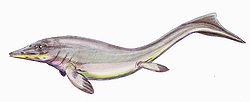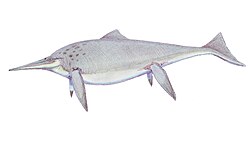| Gulosaurus Temporal range: Early Triassic, | |
|---|---|
| Scientific classification | |
| Kingdom: | Animalia |
| Phylum: | Chordata |
| Class: | Reptilia |
| Order: | † Grippidia |
| Genus: | † Gulosaurus Cuthbertson, Russell & Anderson, 2013 |
| Type species | |
| †Gulosaurus helmi Cuthbertson et al., 2013 | |
Gulosaurus is an extinct genus of basal grippidian ichthyopterygian known from the Early Triassic Vega-Phroso Siltstone Member of the Sulphur Mountain Formation of east-central British Columbia, Canada. Gulosaurus was first named by Robin S. Cuthbertson, Anthony P. Russell and Jason S. Anderson in 2013 and the type species is Gulosaurus helmi. [2] The name means 'Helm's wolverine lizard' and refers to the Wolverine Nordic and Mountain Society, who maintain the area around Wapiti Lake where it was found, and to Dr Charles Helm, who is a leading paleontologist around this same area. [3]
Contents
Originally Gulosaurus was thought to be either Grippia longirostris or Parvinatator wapitiensis, but as the fossil was incomplete it was uncertain which. In 2013, the other half of the fossil, including its skull, was discovered and this proved it to be a new species entirely, closely related to Grippia and very similar.







